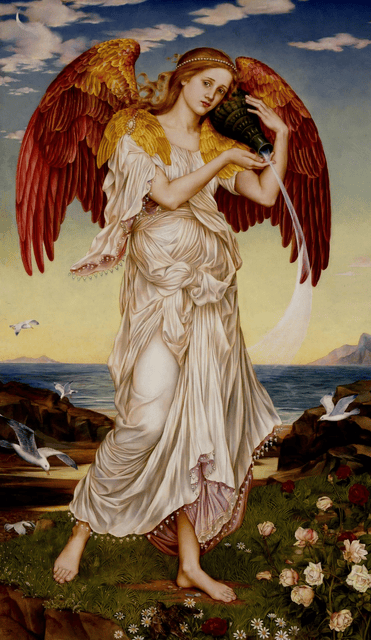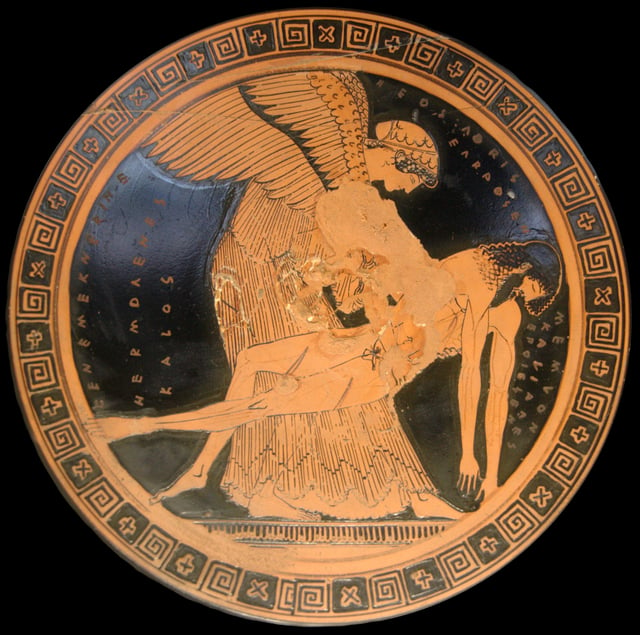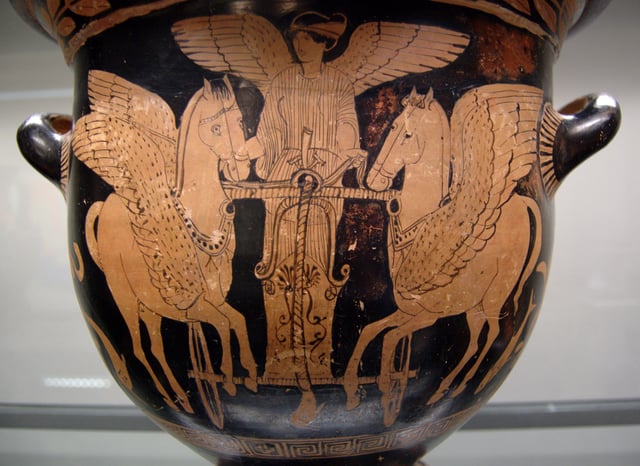Eos

Eos

| Eos | |
|---|---|
Goddess of the Dawn | |
| Abode | Sky |
| Symbol | saffron, chariot, cloak, roses, tiara, grasshopper, cicada, cricket |
| Personal information | |
| Consort | Astraeus |
| Children | Anemoi and Astraea |
| Parents | Hyperion and Theia |
| Siblings | Helios and Selene |
| Roman equivalent | Aurora |
In Greek mythology, Eos (/ˈiːɒs/; Ionic and Homeric Greek Ἠώς Ēōs, Attic Ἕως Éōs, "dawn", pronounced [ɛːɔ̌ːs] or [héɔːs]; Aeolic Αὔως Aúōs, Doric Ἀώς Āṓs) is a Titaness and the goddess[1] of the dawn, who rose each morning from her home at the edge of the Oceanus.
| Eos | |
|---|---|
Goddess of the Dawn | |
| Abode | Sky |
| Symbol | saffron, chariot, cloak, roses, tiara, grasshopper, cicada, cricket |
| Personal information | |
| Consort | Astraeus |
| Children | Anemoi and Astraea |
| Parents | Hyperion and Theia |
| Siblings | Helios and Selene |
| Roman equivalent | Aurora |
Etymology
Eos is cognate to the Vedic goddess Ushas, Lithuanian goddess Aušrinė, and Roman goddess Aurora (Old Latin Ausosa), all three of whom are also goddesses of the dawn. All four are considered derivatives of the Proto-Indo-European stem *h₂ewsṓs[2] (later *Ausṓs), "dawn", a stem that also gave rise to Proto-Germanic *Austrō, Old Germanic *Ōstara and Old English Ēostre / Ēastre. This agreement leads to the reconstruction of a Proto-Indo-European dawn goddess.[3]
Family
Eos was the daughter of the Titans Hyperion, a bringer of light, the One Above, Who Travels High Above the Earth and of Theia, The Divine,[4] also called Euryphaessa, "wide-shining"[5] and Aethra, "bright sky".[6] She was the sister of Helios, god of the sun and Selene, goddess of the moon, "who shine upon all that are on earth and upon the deathless gods who live in the wide heaven".[7] The generation of Titans preceded all the familiar deities of Olympus who largely supplanted them. In some accounts, Eos' father was called Pallas.[8][9]
Eos married the Titan Astraeus ("of the Stars") and became the mother of the Anemoi ("winds") namely Zephyrus, Boreas, Notus and Eurus;[6][10] the Morning Star, Eosphoros (Lucifer);[11] the Astra ("stars")[12] and the virgin goddess of justice, Astrae ("starry one").[13][14] Her other notable offspring were Memnon[15][16][17][18][19] and Emathion[20][21] by the Trojan prince, Tithonus. Sometimes, Hesperus,[22] Phaethon[23][24] and Tithonus[25] (different from the lover) were called the children of Eos by the Athenian prince, Cephalus.
Mythology
Goddess of the dawn
The dawn goddess Eos was almost always described with rosy fingers or rosy forearms as she opened the gates of heaven for the Sun to rise.[26] In Homer,[27] her saffron-coloured robe is embroidered or woven with flowers;[28] rosy-fingered and with golden arms, she is pictured on Attic vases as a beautiful woman, crowned with a tiara or diadem and with the large white-feathered wings of a bird.
Homer
From The Iliad:
She is most often associated with her Homeric epithet "rosy-fingered" (rhododactylos), but Homer also calls her Eos Erigeneia:
Hesiod
Thus Eos, preceded by the Morning Star, is seen as the genetrix of all the stars and planets; her tears are considered to have created the morning dew, personified as Ersa or Herse.[33]
Divine horses
Eos' team of horses pull her chariot across the sky and are named in the Odyssey as "Firebright" and "Daybright". While Quintus described her exulting in her heart over the radiant horses (Lampus and Phaëton) that drew her chariot, amidst the bright-haired Horae, the feminine Hours, climbing the arc of heaven and scattering sparks of fire.[34]
Lovers and children

Eos and the slain Memnon on an Attic red-figure cup, ca. 490–480 BCE, the so-called "Memnon Pietà" found at Capua (Louvre).
Eos fell in love several times. According to Pseudo-Apollodorus, it was the jealous Aphrodite who cursed her to be perpetually in love and have an unsatisfiable sexual desire because once had Eos lain with Aphrodite's sweetheart Ares, the god of war.[35] This caused her to abduct a number of handsome young men, most notably Cephalus, Tithonus, Orion, and Cleitus. The good-looking Cleitus was made immortal by her.[36] She also asked for Tithonus to be made immortal, but forgot to ask for eternal youth, which resulted in him living forever as a helpless old man.[37]
According to Hesiod, by Tithonus, Eos had two sons, Memnon and Emathion.[38] Memnon fought among the Trojans in the Trojan War and was slain. Her image with the dead Memnon across her knees, like Thetis with the dead Achilles are icons that inspired the Christian Pietà.
The abduction of Cephalus had special appeal for an Athenian audience because Cephalus was a local boy,[39] and so this myth element appeared frequently in Attic vase-paintings and was exported with them. In the literary myths, Eos kidnapped Cephalus when he was hunting and took him to Syria.[38][40][41][42][43]
The second-century CE traveller Pausanias was informed that the abductor of Cephalus was Hemera, goddess of Day.[44] Although Cephalus was already married to Procris, Eos bore him three sons, including Phaeton and Hesperus, but he then began pining for Procris, causing a disgruntled Eos to return him to her and put a curse on them.
In Hyginus' report, Cephalus accidentally killed Procris some time later after he mistook her for an animal while hunting.[42]
In Ovid's account, Procris, a jealous wife, was spying on him and heard him singing to the wind, but thought he was serenading his ex-lover Eos.[43]
Cult and temples
There are no known temples, shrines, or altars to Eos. However, Ovid seems to allude to the existence of at least two shrines of Eos, as he describes them in plural, albeit few, in the lines:
- [Eos addresses Zeus :] ‘Least I may be of all the goddesses the golden heavens hold – in all the world my shrines are rarest.’[45]
Ovid may therefore have known of at least two such shrines.
Interpretations
Etruscan

Eos in her chariot flying over the sea, red-figure krater from South Italy, 430–420 BC, Staatliche Antikensammlungen
Among the Etruscans, the generative dawn-goddess was Thesan. Depictions of the dawn-goddess with a young lover became popular in Etruria in the fifth century, probably inspired by imported Greek vase-painting.[46] Though Etruscans preferred to show the goddess as a nurturer (Kourotrophos) rather than an abductor of young men, the late Archaic sculptural acroterion from Etruscan Cære, now in Berlin, showing the goddess in archaic running pose adapted from the Greeks, and bearing a boy in her arms, has commonly been identified as Eos and Cephalus.[47] On an Etruscan mirror Thesan is shown carrying off a young man, whose name is inscribed as Tinthu.[48]
Roman
The Roman equivalent of Eos is Aurora, also a cognate showing the characteristic Latin rhotacism. Dawn became associated in Roman cult with Matuta, later known as Mater Matuta. She was also associated with the sea harbors and ports, and had a temple on the Forum Boarium. On June 11, the Matralia was celebrated at that temple in honor of Mater Matuta; this festival was only for women during their first marriage.
See also
Tithonus
Memnon (mythology)
Aurora (mythology)
Mater Matuta
Zorya
Dawn goddess